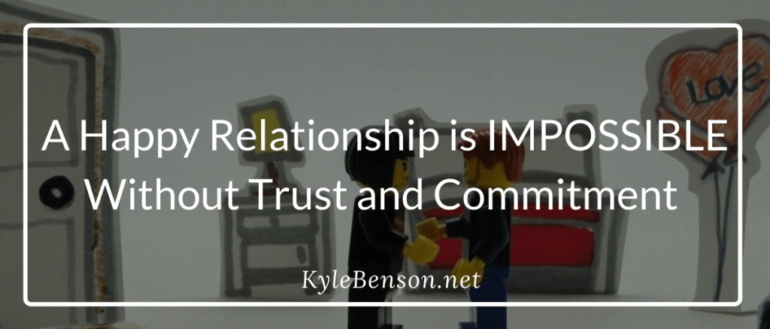Source: https://www.kylebenson.net/relationship-trust-commitment/
Kyle Benson
Believe me when I say, a happy relationship is IMPOSSIBLE without trust and commitment. Don’t believe me? Keep reading.
Love is like Legos. In each passing moment, we are either building a wall between ourselves and our lover or a bridge into each other’s hearts.
Each Lego is an interaction between romantic partners. The deciding factor of whether we open or protect our hearts is the quality of trust.
“Without trust, there can be no meaningful connection.” – Brene Brown
Often trust is seen as a big word. A massive Lego that connects two people, allowing them to connect easily. But this is false.
The Truth About Trust
Trust is built brick by brick, an accumulation of small choices made every day.
Trust is earned slowly. The earliest risks of sharing our hearts with a new person tend to be superficial and impersonal, allowing us to observe how that person responds. If they respond in a trustworthy way, we share more emotionally meaningful stories and feelings with time.
As we build a bridge to another person, we do so by becoming more vulnerable, building our side of the bridge, and engaging fully when the other person is building their part of the bridge to us. Trust between two people NEEDS two trustworthy people.
Speaking of vulnerability, I break down the six commandments of vulnerable communication right here.
Bids for Connection
Dr. Gottman’s research, which is based on observations of both happy and unhappy couples in his Love Lab, highlights that trust is built in the tiniest of moments. He calls these bids for connection because each moment offers an opportunity for emotional connection.

Sometimes these bids are small Lego bricks that appear insignificant, and if they are ignored on occasion, it’s not a big deal because one missing or ill-placed brick can be replaced by another brick in the future. But if the small bids are ignored on a consistent basis, we start to feel unappreciated, unloved and hurt. We start building a wall between ourselves and our partners. We share less and don’t ask for what we need.
Some bids are more precious Lego bricks and need lots of trust to take the risk. That’s why we only share them with a select few people throughout our lives. It takes time for us to work up to placing these bricks on the bridge.

In Drs. John and Julie Gottman’s book, they share that every partner’s number one concern in a relationship is trust. Their number one fear is betrayal.
What is Trust?
According to Dr. Gottman, trust exists in a relationship when partners behave in ways that are in the best interest of both partners. The more trust in a relationship, the more you have each other’s back.
Trustworthiness, according to Dr. Gottman, is each partner’s willingness to make sacrifices for the relationship.
When partners are trustworthy, they are inherently saying to their significant other, “You can depend on me.” Repeated demonstrations of trustworthy behavior allow lovers to take shelter within the relationship.
To maintain trust, both partners have to be fully committed. Without commitment, there is no security in trusting.
100% Emotionally Invested
When partners are 100% emotionally invested in building their relationship over the long haul, they reap the following benefits:
- The relationship becomes a safe haven to continually regain emotional stability, reduce stress/fears/anxieties, and regulate our emotions
- The relationship is built on a “we-ness,” with an ongoing attitude of teamwork
- Loyalty: We see each other as irreplaceable
- We build a bridge to each other and a wall to keep alternative relationships out
- We cherish each other and the relationship and cultivate gratitude
- We’re there for each other no matter what
- We have a positive love story and intentionally think about our lover’s good qualities while avoiding a fixation on their flaws
- We make pro-relationship choices and sacrifice opportunities for short-term indulgences in order to protect the relationship, even when we do not immediately know how doing so may benefit ourselves
- When there are issues, we kindly express our needs and feelings to our partner in a constructive manner, rather than distancing ourselves, cultivating resentment, or whining to others about our relationship problems
- We take more risk and explore the world because we know we have each other’s back if something doesn’t go well
- We don’t get nasty during conflicts with our lover
- We’re willing to acknowledge our personal flaws and work on things because we know we are worthy of love, connection, and growth
- We are more curious about the world, our lover, and ourselves. As a result, we are open to new information that may change our beliefs
- We assume the most generous thing about our partner’s words, intentions, and behaviors
When both partners are trustworthy and committed to the relationship, they invest more in the relationship, make sacrifices on behalf of the well-being of both partners, and nurture gratitude for what they have. In essence, they are intentionally making a decision to stay in love day after day.
Trust + Commitment = Security

“The core of a happy relationship is a deep trust that partners matter to each other and will reliably respond when needed.” – Dr. Sue Johnson
In the early history of our species, we survived by staying close to each other, and as a result, our brains adapted by building an attachment system that:
- Monitors the emotional and physical closeness to our lover as adults
- Motivates us to reach out to our lover to ask for support when we are unsure, upset, or feeling low
- Rely on our lover as a secure base to enhance our personal growth and promote exploration in the world
Essentially, this attachment system is scanning the relationship and asking, “Is it safe? Can I depend on this person? Is this person trustworthy? Are they committed to me?”
When we perceive disconnection, real or imagined, with our lover, or sense something that may threaten the security of the relationship, our attachment alarm goes off.
The goal of the attachment system is to get security and protection from our partner. It motivates us to seek closeness when we are distressed. When this goal is not met, all Legos break loose.
Less Security, Nastier Conflict
Couples who have built trust in their relationship have drastically different conflict conversations than couples who struggle to trust one another.
Couples with a high trust metric, as per Dr. Gottman’s research, are more affectionate and kind during the conflict. They focus on maximizing the benefit for both partners and are calmer and accepting of their lover’s sadness or anger…even if the anger or sadness is a result of something they, as the lover, did.
When our lover is emotionally unavailable or unresponsive to our feelings or needs, it’s like the Lego bridge beneath our feet is crumbling. We feel lonely and helpless.
In such situations, our mature brain gets hijacked by our primal brain and we experience what neuroscience Jaak Panksepp calls a primal panic. When we experience this, we try to maintain our relationship by becoming demanding or by withdrawing.

These methods may work initially, but the more they are used, the more toxic cycles of insecurity are formed in the relationship. Since neither partner trusts the other to be there for them, they become increasingly defensive and assume the worst about each other.
The longer partners go without trust, the more they start behaving like they are at war with each other, rather than like they are lovers.
Practically every conflict conversation is about building trust and commitment. Directly or indirectly, both partners are evaluating the security in the relationship and asking:
- “Can I trust you to stay faithful?”
- “Am I the most important person in your life?”
- “Will you listen to my sadness? Hear the longings beneath my anger?”
- “Will you be there for me when I have a bad day? Am overwhelmed? When I need you?”
When security in a relationship is not created or maintained, partners begin betraying each other.
The Opposite of Trust is Betrayal
Dr. Gottman not only created a trust metric but also devised a betrayal metric which measures “how unwilling each partner is to sacrifice for the other [partner] and the relationship.” Essentially, betrayal happens when a partner tries to get the best deal for themselves at the cost of their partner’s well-being.
Examples of betrayal include:
- Continually not listening to feelings or needs
- Withdrawing without any reassurance to your partner
- Threatening to end the relationship as a way to manipulate your partner into committing
- Emotional and sexual affairs
- And more.
When a couple’s betrayal metric is high, it leaves the relationship and partners vulnerable to infidelity and other forms of disloyalty.
How does betrayal happen?
Here is the Gottman-Rusbult-Glass Betrayal Cascade
- Turning away or against bids for emotional connection (dismissing emotions and losing emotional connection)
- The conflict escalates, and repairs fail to de-escalate conflict
- Self-disclosing feelings and needs are replaced with criticism, and conflict is avoided
- Focus on trashing the partner in thoughts, rather than on cherishing the partner’s positive traits
- Negative comparisons (real or imagined). Start thinking “I can do better with someone else.”
- Less investment in the relationship and seeking emotional connection outside the relationship
- Slowly building a wall between your partner and yourself and a bridge to someone else
- Viewing partner as replaceable and finding others more desirable
- Infidelity
Betrayal happens by the small choices we make, brick by brick. Part of these choices are due to the interactions in the relationship. Another part is due to self-gratification. The remaining part of these choices are influenced by our past experiences of trust and commitment.
This is why insecure individuals struggle to build a secure relationship.
Early Experiences of Security

Like Lego instructions, our minds form a blueprint based on our early relationships on how to regulate our emotions, what to expect in our relationships, and how to assign meaning to specific actions of our lovers.
Depending on how we were loved early in life, we likely formed one of three love styles.
Secure
Your caregivers were responsive, caring, and emotionally available. All emotions were welcome and you felt supported.
As a result, you see yourself as worthy of love and view others as trustworthy and willing to commit to you.
Because of this, you view relationships as workable. You’re open to learning how to be a better partner or patiently teaching your partner how to be a better lover to you. In conflict, you openly share your disappointment and ask for support from your partner in a gentle way.
Clingy
You, caregivers, were affection and caring, but inconsistently available to meet your needs.
As a result, you tend to be insecure about your own self-worth and lovability.
Due to the lack of trust and uncertainty of commitment, you frequently seek validation and reassurance that you are lovable. During a conflict, you may become hostile and catastrophize the conflict by bringing in irrelevant issues. The deep fear of abandonment leads you to try and control your partner by making demands or threats, which harms trust in a relationship.
Distant
Due to early experiences of being neglected or controlled by your caregivers, you take on a mindset of “I won’t depend on anyone” and view others as fundamentally unreliable and untrustworthy.
To protect yourself from being hurt, you tend not to fully commit and/or to behave in ways that do not offer reassurance, trust, and security in the relationship.
While our early experiences offer us a blueprint on how to love and be loved, our adult relationships offer the opportunity to modify the blueprint into something more secure.
When we invest in our relationship and work to bring our best selves, we change how we love. We become more open, more trusting, and more secure in the belief that we are worthy of love and connection.
Building Trust, Commitment, and Security
Building trust is like building a house with Legos. You have to negotiate and work together in ways that consider both partners’ well-being. Each partner has to show up and bring their best self and intentionally focus on being kind, patient, generous, and loving to each other and themselves.
For the house to stand the test of time, both partners have to be committed to repairing, working through issues, making time for play and connection, and truly caring about each other.
Skills & Actions That Build Trust and Commitment
Working through conflict:
Building trust requires moving from attack-defend mode into sharing feelings and collaboration mode.
The first step is to understand each other before you try to resolve your issues. When you do this, you transform conflict into a catalyst for connection and trust. A trustworthy partner sees their partner’s problems in the relationship as their own problems and works hard to fix things.
Healing past emotional wounds
To rebuild trust, it’s vital that couples dig up past events where trust was broken and work through them together so the pain is no longer a barrier between them.
Be responsive to bids for connection
Sometimes the seemingly insignificant bids for connection are the most meaningful of all. Do your best to be aware of the bids your partner makes and respond by connecting with them.
Attunement
Attunement is the ability to delight in your partner’s joys and success and feel troubled when they are going through a hard time. It is only possible when we understand each other on a profound level.
The most frequent block to attunement, especially with difficult emotions, is how partners feel about difficult feelings.
Be emotionally available
Stay open to your partner even when you feel insecure. This includes learning to work with your emotions so they don’t overwhelm you and cause you to attack or withdraw.
Be a reliable lover
Trust is built when your words and actions align on a consistent basis. In essence, you say what you’re going to do and you follow through.
Holding yourself accountable
When you make an error, you take ownership of your mistake, apologize, and repair. It’s impossible to trust someone who doesn’t take responsibility for their actions.
Protect your lover’s vulnerabilities
When vulnerabilities and insecurities are used as weapons in a relationship, partners have betrayed each other. Building trust is protecting what your partner has shared with you and not using it against them, even when you’re upset.
Ask for help
A trusting relationship is only developed when both partners can ask for help. This means expressing wants and needs openly.
If you think less of yourself for needing help, then you have some personal work you need to do to address the subconscious double standards. Because, as Brene Brown puts it, “You cannot judge yourself for needing help but not judge others for needing your help.”
Small Steps Establish Trust and Commitment
While most believe that trust is created by the grand gestures in a relationship, the research cited in this piece highlights that trust is built in small, seemingly insignificant moments. These are the moments that demonstrate your commitment to your partner. They’re the moments that highlight you as a trustworthy lover and as someone capable of deeply caring for and protecting your partner’s heart.
Looking at all of the research in the context of my work with couples, it’s crystal clear that a happy and long-lasting relationship is built on a rock-solid foundation of trust and commitment.
For most of us, we have to learn what this looks like and how to build it in our relationship.
Lucky for both you and me, our relationship keeps handing us new Legos to rebuild, repair, and reinvent ourselves and our relationships. When we devote ourselves to cultivating mutuality and to offering our full selves to our lover, and when they do the same, we build something deeply meaningful and beautiful.
With love,
Kyle Benson








